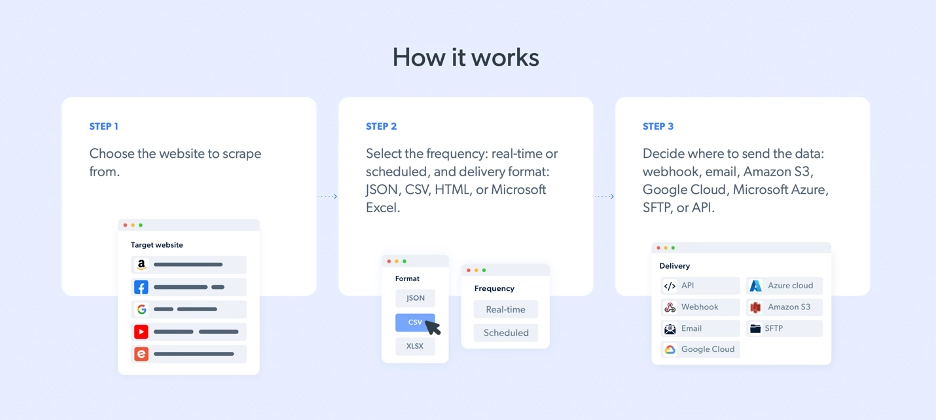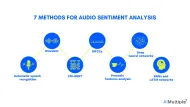“This was great!”
“I had a horrible experience.”
The sentiments in these sentences can be inferred from certain words, such as “great” and “horrible”. By analyzing the sentiments of reviews, feedback, and other customer interactions, businesses can improve their marketing campaigns.
Explore eight cases of sentiment analysis in marketing along with four benefits of sentiment analysis marketing:
Use cases of sentiment analysis marketing
1. Social listening
Social media platforms are a goldmine for understanding customer sentiment in real-time. Sentiment analysis tools process social media posts and comments to gauge public opinion about your brand, product, or even industry trends. By analyzing social media sentiment, marketers gain insights into what customers love or dislike and can tailor campaigns accordingly.
Real-life example: The Atlanta Hawks used sentiment analysis to adjust their social media strategy, leading to a 127% increase in video views and a 170% boost in audience growth in just three months.1
2. Brand insights and crisis management
Customer sentiment can reveal strengths and weaknesses in products and services. Monitoring sentiment in real-time helps brands identify negative trends early, preventing potential PR crises. Brands can also turn positive feedback into brand stories, showing they genuinely understand and respond to customer needs.
Example: During a product issue, if sentiment analysis detects a surge in negative sentiment, companies can quickly release a statement or a fix to address customer concerns, preventing escalation.
3. Competitive analysis
With sentiment analysis, you can gain insights into how customers feel about your competitors. By analyzing public feedback on rival brands, you can benchmark your performance, pinpoint areas for improvement, and spot opportunities for differentiation.
Example: If a competitor’s product receives consistent complaints about durability, you can emphasize your product’s durability in your own marketing, attracting customers seeking reliable options.
4. Opinion mining for deeper insights
Opinion mining goes beyond simple positive or negative sentiment, exploring specific emotions like joy, frustration, or enthusiasm. This granular understanding of customer emotions helps refine market research, campaigns, and customer service strategies.
Example: A retail brand could find that customers are “very happy” with product variety but “frustrated” with customer service. This insight directs efforts where they are most needed to boost overall satisfaction.
5. Voice of Customer (VoC) analysis
VoC analysis captures customer feedback at each interaction across the journey, from purchase to support. By integrating sentiment analysis into VoC programs, brands can continuously improve customer experiences based on real-time feedback, fostering customer loyalty.
Example: If VoC sentiment analysis detects dissatisfaction with a checkout process, brands can simplify it, increasing conversion rates and customer satisfaction.
6. Market research and trend analysis
Sentiment analysis allows marketers to monitor shifts in market sentiment, such as reactions to trends, industry changes, or public events. By analyzing sentiment around these topics, marketers can adjust strategies to align with customer expectations and predict changes in demand.
Real-life example: James Hardie, a building materials company, used social listening tool for in-depth market research. By examining online conversations and sentiment, they uncovered industry trends, customer preferences, and competitor strategies, enabling them to enhance product development, refine sales tactics, and improve business operations.2
7. Influencer prospecting
Finding influencers with audiences that align with your brand’s sentiment is essential for authentic collaborations. Sentiment analysis helps identify influencers who not only resonate with your target market but whose audiences view relevant topics favorably.
Example: If a brand identifies an influencer whose followers have a high positive sentiment toward eco-friendly products, it can launch a campaign with that influencer to reach an environmentally-conscious audience.
8. Campaign performance analysis
Understanding campaign performance in real-time allows brands to optimize their approach based on audience sentiment. Sentiment analysis tools let marketers assess reactions by demographics and regions, refining messages for maximum impact.
Example: A brand can track sentiment on a new ad campaign, identifying positive reception among younger demographics but neutral or negative sentiment among older audiences. This insight allows the brand to tailor future ads for broader appeal.
Benefits of marketing sentiment analysis
1. Understanding your audience
Understanding your audience is crucial to have a successful marketing campaign. This can be done on several platforms:
Twitter, Facebook and Instagram can be scraped to check for sentiments and perceptions of people about your brand or products and services. People also often write blogs and review articles which can be of help too.
- Any conversations with your customers through emails, text messages or complaint/feedback forms can also be useful to check responses to your products and tailor marketing campaigns accordingly.
- Sources such as newspapers and online forums can also be scraped to better understand what people think of your business.
- These techniques can help you evaluate your reputation and customer demographics, such as age and gender, in the market so you can know your target audience and who you need to focus on in your marketing strategies.
- Another way to see customers’ reaction is also by scraping data from influencers’ pages to see what they and their followers say about your products. Research suggests that 81% of consumers surveyed bought a product by a link shared by an influencer.3
For instance, KFC, Pizza Hut, and McDonalds, use sentiment analysis with their customer feedback and food preferences. This helps them in improving customer experience and increasing sales.4
Also, check our data-driven list of sentiment analysis services if you think your company can benefit from sentiment analysis.
2. Staying competitive
- Sentiment analysis can also help in determining where you stand among competitors. You can check customer feedback also for your competitors to see how consumers are responding to their products and which aspects of their products do they find good or bad.
- All the tools which you use to gather data for your product’s analysis can also be used for your competitors as long as the data used is publicly available. For example, web scraping tools help businesses and individuals automatically extract company data from web sources. You can then use this data to check how consumers are rating their products and make a comparative analysis with your own products.
- You can also include any non customer feedback, such as those of bloggers or people mentioning any reasons for disliking/avoiding your product. This information can help you prepare better competitive products.
Sponsored:
Bright Data’s Data Collector can help with scraping data from online platforms which can be used for sentiment analysis.

Source: Bright Data5
3. Making better advertisements
- You can also check for public reactions to certain controversial or trending topics and use that as an advantage to make better advertisements.
- One such example is of Coca Cola using a message of inclusivity in its Super Bowl ad of 2019.6
- However, you need to be careful about sensitive topics. For instance, Pepsi’s ad of 2017 backfired as people thought it trivialized the protest movements for Black Lives Matter.7
- Sentiment analysis can help you determine whether your marketing campaign is appropriate for different places and cultures. One place may take the ad positively while another group of the people may see it as harmful to their culture.
4. Preventing setbacks and crises
- If your product is experiencing an impending problem and you can see customers talking about it, then it can be used for your benefit by taking swift action and fixing any upcoming crises.
- You can also keep a check on your customer service’s operation and success by seeing how people are providing feedback to you. You can make them fill anonymous customer surveys to make sure your customer services are helpful and quick.
- One research has shown that companies can lose money due to bad customer service, making customers switch to another brand.8
What are some challenges of using sentiment analysis?
- It can be difficult to determine the tone of comments as at times there can be neutral comments which do not give much information but can be mistaken as positive or negative by the algorithm or even left out. For instance, in the sentence “The restaurant is located at a busy place”, it’s difficult to understand whether being busy here is something negative or positive.
- Some comments are sarcastic, such as “What a great idea!” can be shared as a tweet with an absurd marketing campaign idea as sarcastic criticism which can be mistaken for a positive remark.
- People often comment with emojis or idioms, which again can be difficult to teach the algorithm to categorize. Similar problems can come with customers using more than a single language in comments.
What is sentiment analysis in marketing?
Sentiment analysis in marketing helps brands understand customer emotions, opinions, and attitudes toward their products, services, and campaigns. By analyzing customer sentiment in sources like social media posts, reviews, and survey responses, companies can gauge overall sentiment as positive, neutral, or negative.
Using sentiment analysis tools with natural language processing (NLP) and machine learning, marketers uncover valuable insights into customer experience, loyalty drivers, and areas needing improvement. This deeper understanding of brand sentiment enables companies to adjust marketing strategies, strengthen brand health, and respond to customer preferences more effectively.
Further Reading:
External Links
- 1. Inside the Atlanta Hawks' Slam Dunk Social Strategy | Sprout Social. Sprout Social
- 2. How James Hardie® optimized operations with Sprout Social | Sprout Social. Sprout Social
- 3. Newsroom | Business Wire. Business Wire
- 4. HOW BIG DATA IS THE BEST INGREDIENT OF THE FOOD INDUSTRY? .
- 5. Web Scraper API Pricing Plans. Bright Data
- 6. Coca-Cola reveals new Super Bowl ad promoting inclusion, diversity - National | Globalnews.ca. ETCanada.com
- 7. Pepsi Pulls Ad Accused of Trivializing Black Lives Matter - The New York Times. The New York Times
- 8. Businesses Lose $75 Billion Due To Poor Customer Service.



Comments
Your email address will not be published. All fields are required.